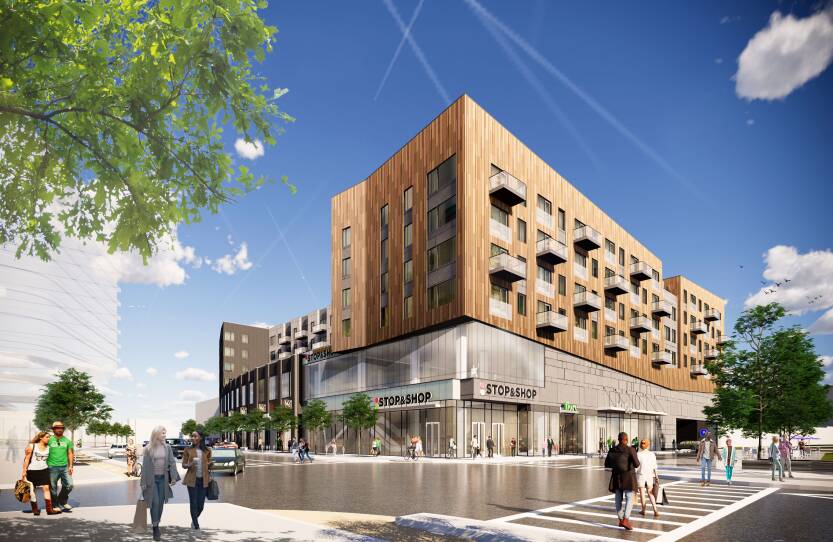Allston Yards is a massive new development slated to go up on the edge of I-90, next to the Boston Landing Commuter Rail station. Locals are calling it one of the biggest residential developments in Allston-Brighton history.
The site is currently a sprawling parking lot and a strip mall, home to Stop & Shop, HomeGoods and Dollar Tree. If developers have their way, the approximately 10-acre property will be home to a more than 1 million square-foot development. It will include three apartment buildings with more than 850 units, an office building, some green space, a supermarket and a new network of streets. But activists have concerns, and they are primarily directed toward the city of Boston.
At a public meeting in late November, the developers rattled off a bunch of changes they had made in response to community feedback. The list included increasing the percent of condos required to be owner-occupied, increasing the number of affordable units and ensuring the park is a permanent feature of the project.
Then, they opened the microphone to the public. Many comments were positive. Some asked for more affordable housing. Others asked for clarification on a proposed fund to help residents become homeowners. Still others worried that the green space was insufficient. However, many members of the Brighton Allston Community Coalition (BACC) saved their harshest criticism for the city.

What the commenters found galling, they said, was that the public comment period ends this week — on Dec. 9 — and a legal notice suggests that on Dec. 12, the Boston Planning and Development Agency (BPDA) will vote on approving the development.
"That's an insult," said Jim Prince, who is part of the BACC and has lived in the neighborhood for 59 years. "There is no way that they can take into account the comments, review everything, discuss it and vote on it."
Prince views this short window as a signal that resident feedback from this comment period is not being taken seriously.
"The city has decided this project is going forward and that's the way it's going to be. And, unfortunately, this happens all the time,” said Prince. “The process stinks."
City Councilor Michelle Wu echoes this sentiment.She has called for abolishing the BPDA because, she says, it serves only the privileged and the powerful.
Prince said he’d like to see the BPDA "spend just a little bit more time” and he asked that they not “B.S. us."
Boston’s BPDA declined to be interviewed, but in a statement said: “The current proposal for Allston Yards has evolved significantly since it was originally submitted to the Boston Planning & Development Agency (BPDA) over two years ago. Following 12 public meetings and two previous comment periods, the current proposal is reflective of the feedback received by the community.”
The statement also said the agency is reviewing comments as they are received and that it “[has] not determined if the project will be recommended for approval at the December BPDA Board meeting.”
A final determination about Thursday's agenda will happen on Tuesday afternoon, just 48 hours before the meeting, according to a BPDA spokesperson.
John Twohig, executive vice president of New England Development — which is partnering with Stop & Shop on Allston Yards — defended the timeline and said the public has had plenty of time to comment.
“Anyone that says this [timeline] is insulting, quite honestly, their motivation is probably just to delay the project," said Twohig. "Name a project like this that has been three years in the community, and the number of community meetings that we have done, the outreach that we have done, the responsiveness that we have had, the extended comment periods that we have given at every stage."
So, is this a model for how to manage a big development or a big insult to neighbors? The answer may lie outside of Boston.
Roberta Schur, the Community Development Manager at the Tacoma Housing Authority in Washington state who has worked in other locations around the country, said there's no one way to make sure the community isn't "insulted."
"What works in one neighborhood wouldn't necessarily work in another neighborhood," said Schur.
But, she said, there are ways to mitigate resentment. Take the Hilltop neighborhood in Tacoma as an example, she said. It’s a place where there’s a lot of rapid development, like Allston-Brighton, and there’s a lot of fear there about the changes.
"We didn't have what you would call public meetings," Schur said. Instead, they hosted what they called "design labs," among other initiatives.
The project's architectural team brought on people from the local community who hosted these "design labs," but there was no big room, no presentation and no microphone for people to line up at during the comment period.
"We would have 75-plus people,” said Schur. “We had maps out on the table and people [were] putting post-it notes everywhere and saying what they liked and didn't like."
Schur said the goals of their process were to reach out to community members who often are not involved in discussions about development, and to include local organizations and groups in the planning process.
“People felt genuinely heard," she said, adding that this is because people saw real, substantive changes in how the buildings would look and feel based on their input.
Schur acknowledged it’s harder if a development is 100 percent private and there’s a strong profit motive. However, she said, the core principles remain: A willingness to tailor everything to the specific neighborhood and adapt when residents propose reasonable changes.
Back in Allston, Prince said he does not believe that kind of willingness exists with Boston officials who oversee the developers. But with a lot more development coming to Allston-Brighton, he said, even if neighbors feel steamrolled, they’ll still show up to try to make their voices heard.





